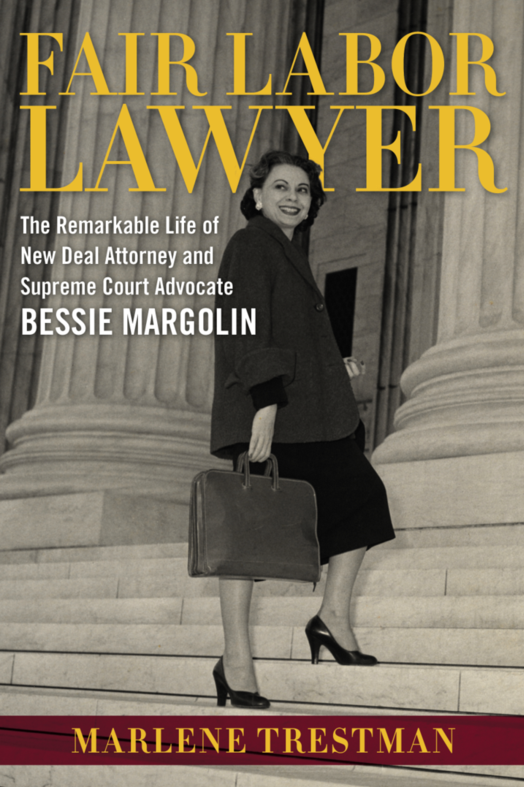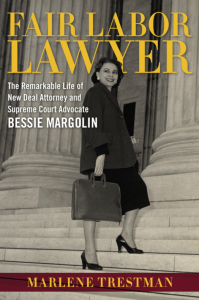
Fair Labor Lawyer: Bessie Margolin’s Journey from New Orleans Orphanage to Supreme Court Advocate
 Not every biographer has the keen advantage of having met her subject. Marlene Trestman, author of Fair Labor Lawyer: The Remarkable Life of New Deal Attorney and Supreme Court Advocate Bessie Margolin (LSU Press, March 2016), was lucky enough to not only have known Margolin but also to have been mentored by her.
Not every biographer has the keen advantage of having met her subject. Marlene Trestman, author of Fair Labor Lawyer: The Remarkable Life of New Deal Attorney and Supreme Court Advocate Bessie Margolin (LSU Press, March 2016), was lucky enough to not only have known Margolin but also to have been mentored by her.
From Margolin’s childhood in the New Orleans’ Jewish Orphanage to her Supreme Court advocacy and behind-the-scenes work at the Nuremberg trials, Trestman lets the reader glimpse Margolin’s character, and her sometimes scandalous love affairs which give added dimension to this fascinating historical figure.
Trestman, former Special Assistant to the Maryland Attorney General, is a notable attorney in her own right who was fostered at age 11 by the same Jewish agency that took care of Margolin. Recently, the biographer talked to Hanna R. Neier about Margolin’s struggle with gender inequality, the life of a Jewish orphan in New Orleans, tikkun olam and the Supreme Court.
HRN: Why did you want to write Bessie Margolin’s story?
MT: It’s a bit of a stretch to say I “wanted” to write Bessie Margolin’s story. Instead, as one of the most influential women attorneys of the 20th century, she deserved to have her story written, and I felt I had a duty to find someone who would write it. It took me years before I decided that I could do justice in telling her remarkable story. Margolin and I shared common childhood experiences, albeit separated by 50 years. From 1913 to 1925, she grew up in New Orleans’ Jewish orphanage, which closed in 1946. In the mid-1960s, I became an orphan whose foster care was supervised by the agency that earlier had run the orphanage. We both attended Isidore Newman School, which had been founded to educate Jewish orphans. These shared experiences prompted our meeting, and we stayed in close contact throughout my years in college, law school, and into the start of my career as a government lawyer. She was a generous mentor and powerful role model for me, and we had both received life-changing social services and educational opportunities from two wonderful New Orleans institutions.
2 comments on “Fair Labor Lawyer: Bessie Margolin’s Journey from New Orleans Orphanage to Supreme Court Advocate”
Comments are closed.




The U. S. Civil War took place between 1861-1865. As the Civil War ended twenty years before the date given for (presumably) the opening of the “New Orleans’ Jewish Orphans’ Home” (1885), the Orphanage’s history could not be said to span the time from Civil War to World War II.
However, the “Jewish Children’s Home” was in fact founded in 1855 as the “Jewish Orphans’ Home”, and has since undergone several name changes: 1880-1905, “The Association for the Relief of Jewish Widows & Orphans”; 1905-1924, “The Association for the Relief of Jewish Widows & Orphans of New Orleans”; after 1924, “Jewish Children’s Home”; and since 1958 it has operated as the ” Jewish Children’s Home Service”, while retaining the legal name of “Jewish Children’s Home”.
Thanks, Piffle, for your close reading and for catching a typo in the last paragraph. It should have read “orphanage’s rich history from 1855 [not 1885] to its closure in 1946.” The Home, known by various names, was founded in 1855 and thus its operation spanned (i.e., included but was not limited to) the Civil War through World War II. Today, the agency that succeeded the orphanage is known as the Jewish Children’s Regional Service. http://www.jcrs.org